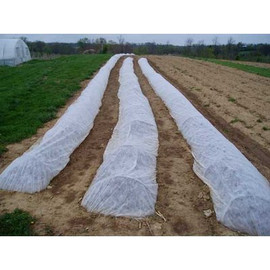
Call us toll free today 800.635.3621
 Many gardeners would like to extend the growing season as far into fall as possible. Using row covers can protect your plants from frost so that you can continue to harvest vegetables well into the fall.
Many gardeners would like to extend the growing season as far into fall as possible. Using row covers can protect your plants from frost so that you can continue to harvest vegetables well into the fall.
Row covers are made of light, permeable material (usually polypropylene or polyester). They are available in several weights that provide different levels of protection from frost. Row covers can be laid loosely over plants, weighted on the ground, or supported with wire hoops.
Floating row covers are the lightest-weight type. They allow air, water, and up to 85 percent of light to pass through the material. Floating row covers provide only a few degrees of frost protection, but they can shield your plants from many pests.
If you cover your plants with floating row covers, leave enough slack in the material to allow the plants to grow. Bury the edges in the soil or seal them in another way to keep pests from damaging your plants. Anchoring row covers with rocks or soil can rip the material. Try anchoring them instead with plastic soda bottles partially filled with water or plastic bags partially filled with soil.
Some crops, such as carrots and onions, can be covered all season. Uncover beans or cabbage after the plants are well grown and pests are no longer a concern. Some plants, such as squash, need to be pollinated by insects and must be uncovered when they begin to flower or be hand-pollinated. If you live in a hot region, you may need to remove your floating row covers to avoid excessive heat buildup that could damage your plants.
If you need more protection from freezing, you can use heavier row covers for up to 8 degrees of frost protection. Heavier row covers block more light, which may slow the plants' growing process. You can get similar frost protection by using two layers of a lighter-weight row cover.
Row covers made from plastic or slitted plastic can increase temperatures by as much as 30 degrees. Plastic row covers need to be vented on warm days and closed up again at night, but slitted row covers do not need to be vented. Colored or shaded plastic row covers can block out some sunlight, which will keep the plants from getting too hot.
Plastic row covers should be suspended over the plants with metal, plastic, wire, or wooden hoops, and the edges should be anchored with soil, boards, pipes, or another material. You can buy wire hoops from a garden supplier or make your own from 9-gauge wire. Use hoops under and over the fabric to hold it in place over your plants.
If you have upright plants that need to be protected from frost, you can put a small tomato cage around the plants, wrap row cover fabric around the cage, and use clothespins to hold it in place.
 Row covers are sold in small pieces that are easy to handle, but it is more economical to buy a large roll and cut it into smaller pieces.
Row covers are sold in small pieces that are easy to handle, but it is more economical to buy a large roll and cut it into smaller pieces.
If a piece of row cover is torn in multiple places, you can cut it into pieces and use it to patch small holes in other row covers. You can sew the patches with waxed dental floss.
When the growing season is over, shake the row covers to remove any dirt and debris. Be sure they are dry, and then fold or roll them and store them in a plastic storage bin for the winter. Use rocks or bricks to weight the top of the bin and keep it closed tightly.
